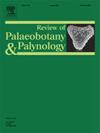产于佛罗里达西北部明矾崖中新世的鸢尾果(鸢尾科)
IF 1.7
3区 地球科学
Q2 PALEONTOLOGY
引用次数: 0
摘要
佛罗里达西北部中新世中明矾断崖植物区系为了解北美东南部现代温带森林的发展和以前的植物区系多样性提供了宝贵的机会。植物区系以前被认为以亚热带到温带的落叶类群为主。在这里,我们提出了新发现的带翅水果属的热带Illigera (Hernandiaceae)。新化石种:黑莓属(Illigera berryi Hai Zhu)。et T.A. Lott是第一个从植物区系中确认的嗜热大化石记录,丰富了已知的植物区系多样性。这一发现扩大了Illigera在北美东南方向的古地理分布,并将该属的已知化石历史从始新世延长到中新世中期。结合先前在北美西部和东亚始新世发现的化石,化石证据表明Illigera在新生代有广泛的分布,并表明该属可能起源于北半球。本文章由计算机程序翻译,如有差异,请以英文原文为准。
Illigera fruits (Hernandiaceae) from the Miocene of Alum Bluff, northwestern Florida
The Middle Miocene Alum Bluff flora in northwestern Florida provides a valuable opportunity for comprehending former floristic diversity and the development of modern temperate forest in southeastern North America. The flora previously was understood to be dominated by deciduous subtropical to temperate taxa. Here, we present newly discovered winged fruits of the tropical genus Illigera (Hernandiaceae). The new fossil species, Illigera berryi Hai Zhu, Manch. et T.A. Lott is the first confirmed thermophilic macrofossil record from the flora and enriches the known floristic diversity. This occurrence expands the paleogeographic distribution of Illigera in North America southeastward and extends the known fossil history of the genus from the Eocene to the Middle Miocene. Combined with previously recognized fossil occurrences from the Eocene of western North America and eastern Asia, the fossil evidence indicates that Illigera had a wide distribution in the Cenozoic, and suggests that the genus may have originated from the Northern Hemisphere.
求助全文
通过发布文献求助,成功后即可免费获取论文全文。
去求助
来源期刊
CiteScore
3.50
自引率
21.10%
发文量
149
审稿时长
6 months
期刊介绍:
The Review of Palaeobotany and Palynology is an international journal for articles in all fields of palaeobotany and palynology dealing with all groups, ranging from marine palynomorphs to higher land plants. Original contributions and comprehensive review papers should appeal to an international audience. Typical topics include but are not restricted to systematics, evolution, palaeobiology, palaeoecology, biostratigraphy, biochronology, palaeoclimatology, paleogeography, taphonomy, palaeoenvironmental reconstructions, vegetation history, and practical applications of palaeobotany and palynology, e.g. in coal and petroleum geology and archaeology. The journal especially encourages the publication of articles in which palaeobotany and palynology are applied for solving fundamental geological and biological problems as well as innovative and interdisciplinary approaches.

 求助内容:
求助内容: 应助结果提醒方式:
应助结果提醒方式:


